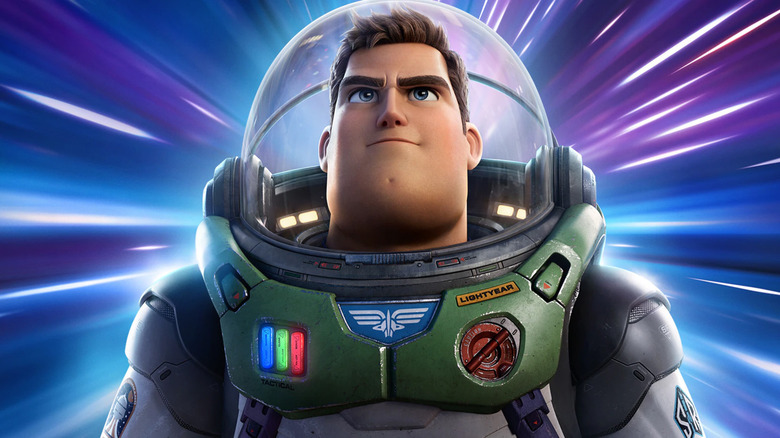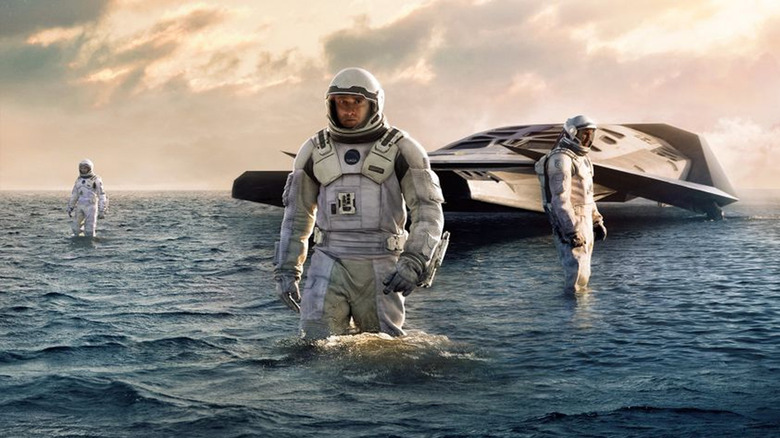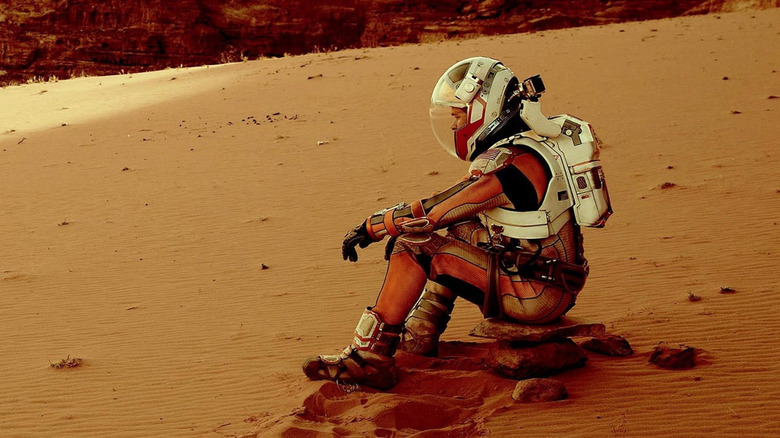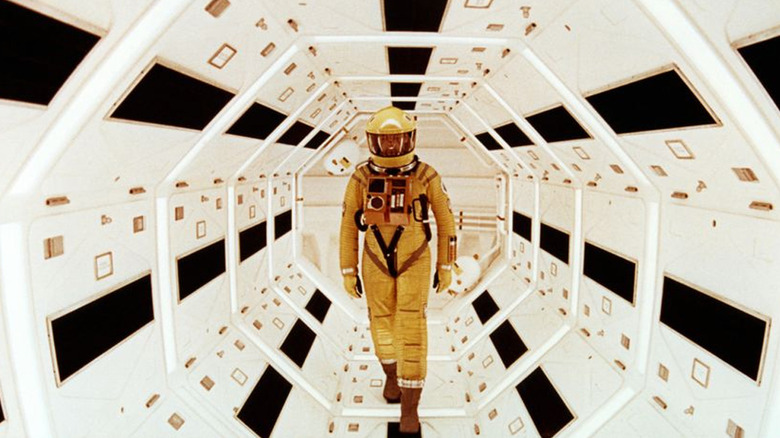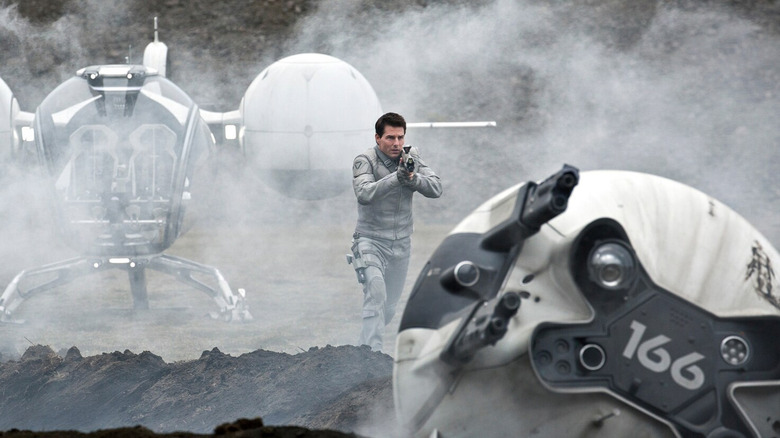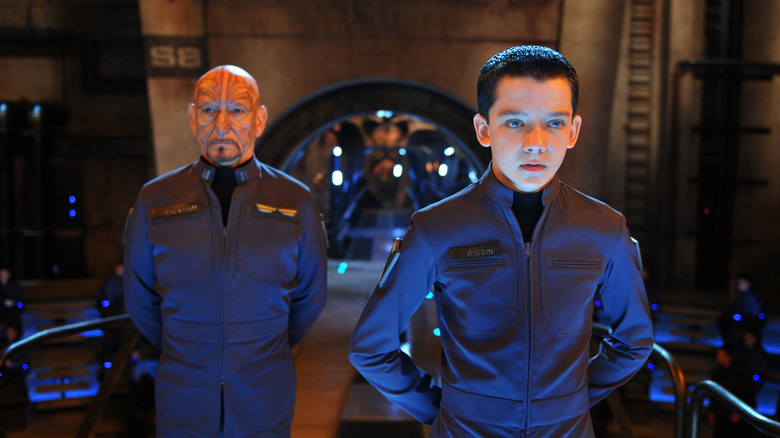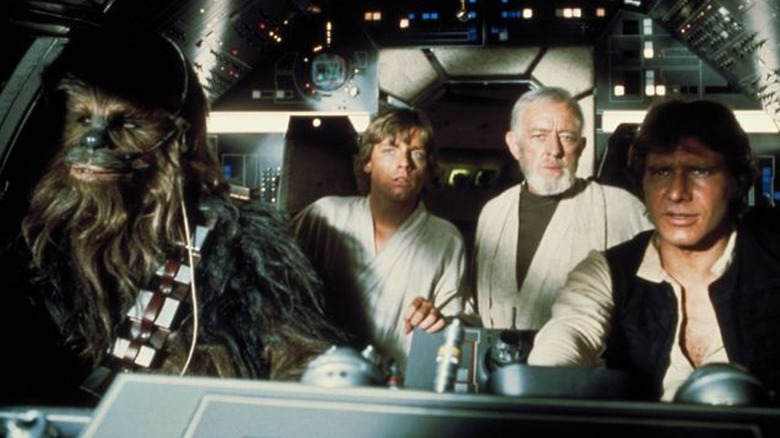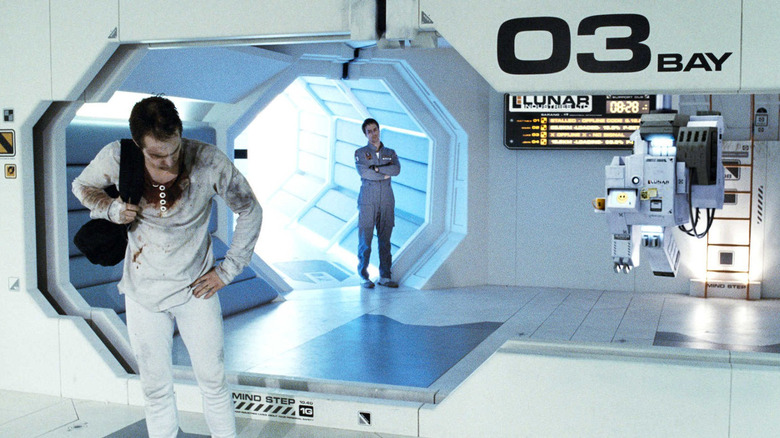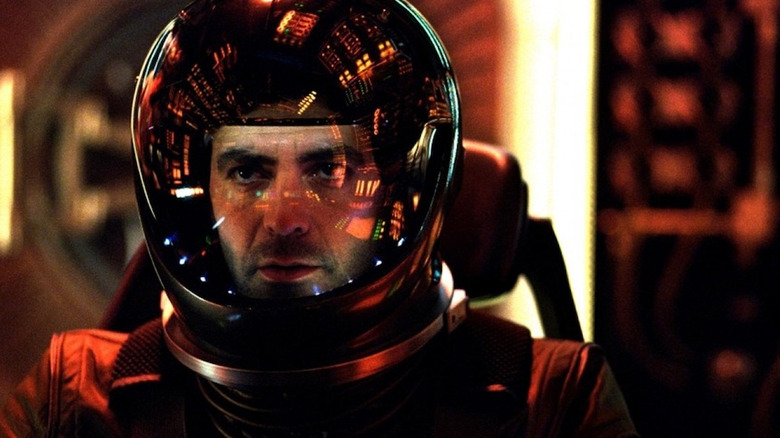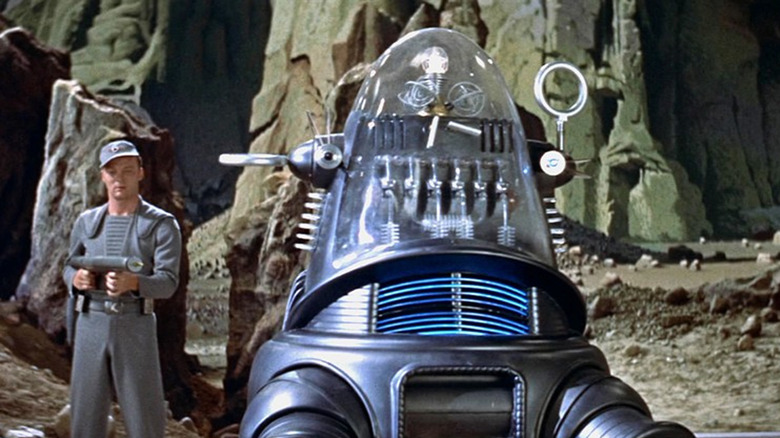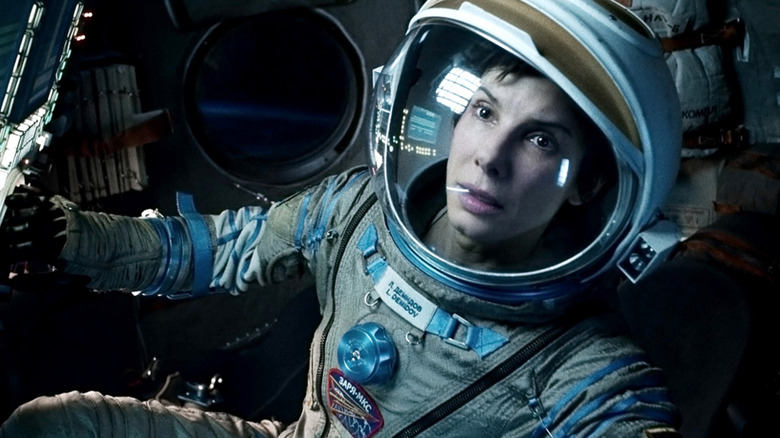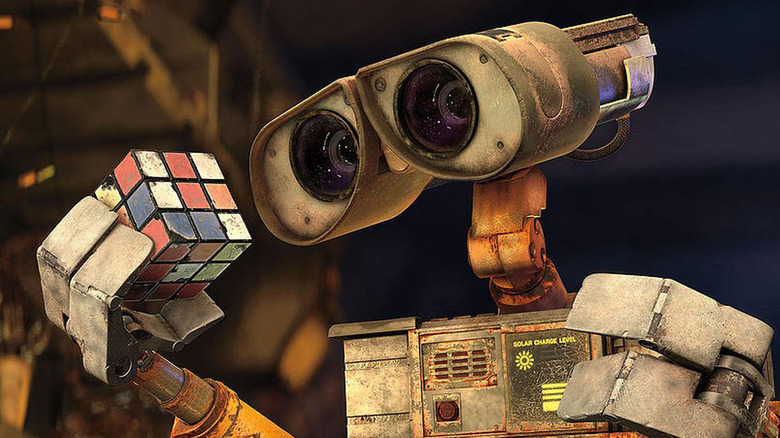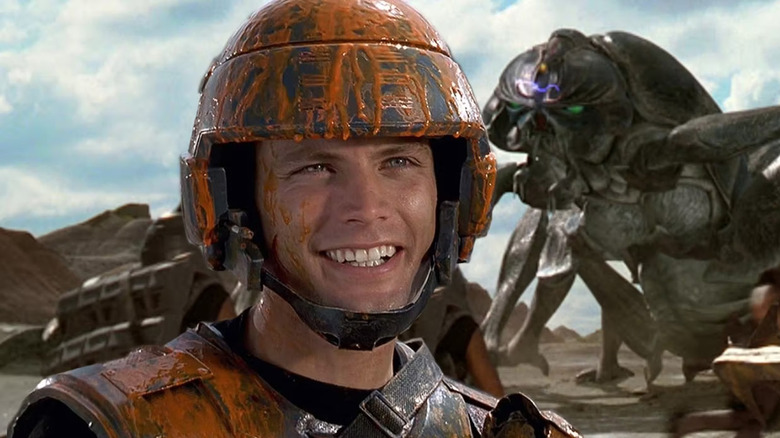12 Sci-Fi Movies To Watch If You Liked Lightyear
It's space, Buzz, but not as we know it. "Lightyear" brings Pixar's toy hero to the big screen in his very own epic sci-fi adventure. An origin story like no other, "Lightyear" is the movie that inspired the action figure.
As the tagline goes, "In 1995, Andy got a toy from his favorite movie ... this is that movie."
The original "Toy Story" introduced us to Woody and Buzz, the now-iconic duo who just wanted to make it to Andy's new home in one piece. A huge success, it created a legacy of tear-jerking sequels. But with "Lightyear," we find out where the story of Buzz Lightyear really comes from.
"Lightyear" is basically the "Star Wars" of the "Toy Story" universe ... sort of. Buzz Lightyear and his Star Command colleagues have been stranded on a hostile planet 4.2 million light-years from Earth. Trying to find their way home, Buzz, along with a bunch of recruits, encounter Emperor Zurg, an imposing, Darth Vader-like figure with an army of robots and a mysterious agenda.
Sound familiar? It should! Although "Lightyear" takes "Toy Story" in an entirely new direction, the film also pays homage to plenty of sci-fi flicks from years past. Whether it's stranded space missions or over-eager space cadets, you'll find plenty of other films that boldly went there before.
Here's our list of all the movies you should watch if you liked "Lightyear."
Interstellar (2014)
No, it's not just a story about a really long space journey. It turns out that "Lightyear" and "Interstellar" actually have a lot more in common than you might think. Sure, Buzz is trying to get back home, just like Coop (Matthew McConaughey) in Christopher Nolan's sci-fi epic. But there are plenty of other parallels, too.
On the face of it, "Interstellar" is about finding a place for humanity among the stars, with former astronaut Joseph Cooper heading off on a special mission to find a new planet for Earth to colonize. That's the general premise, anyway.
"I saw Star Wars when I was 7, and the movie changed everything for people my age," said director Christopher Nolan. "We just wanted spaceships, we wanted space, we wanted that experience of leaving the Earth."
Even this has hints of "Lightyear," albeit in reverse, with Buzz forced to navigate his way back home. But beneath the surface, it's all about time, and so is "Lightyear."
"Interstellar" does funky things with time due to its "time dilation" plot device, a scientific theory that's essentially a difference in how time passed is experienced by two people from different points in space. This comes into play in "Interstellar" when Coop and his crew land on a planet near a black hole, only to find that 23 years have passed in a matter of hours.
This also comes into play in "Lightyear," as it's revealed that Buzz is not only on a hostile planet, but he also finds himself 62 years in the future. Black holes? Gravitational anomalies? Who knows. But it gives "Lightyear" a neat link to one of sci-fi's most divisive epics.
If you love all this timey-wimey stuff, you'll love "Interstellar." Plus, it boasts some brilliant performances from the likes of McConaughey, Anne Hathaway, Jessica Chastain, and even Matt Damon. Absolutely out of this world.
The Martian (2015)
Speaking of Matt Damon, you'll absolutely want to check out "The Martian." Much like Buzz Lightyear, astronaut Mark Watney finds himself stranded on a far away planet after his mission goes awry. Thankfully, Watney is a pretty resourceful guy. As Damon's character says in the film:
"In the face of overwhelming odds, I'm left with only one option: I'm going to have to science the s*** out of this."
"The Martian" tells the story of how astronaut Watney, also a botanist on Earth, manages to create a habitable space on the surface of Mars after his ground-breaking mission goes sideways. A member of a NASA exploration team, Watney is left behind when a catastrophic storm leaves him missing presumed dead. The entire film is about Watney's survival against all odds, not to mention NASA's one-in-a-million mission to get their man back.
It's a triumphant story and a testament to human ingenuity. It also happens to be an incredibly emotive film as "The Martian" takes you through every stage of Watney's fragile state of mind as he struggles, alone, on an inhospitable planet with only the resources left behind to sustain him.
"Lightyear" is a similarly triumphant story about the plucky astronauts fighting their way back home against all odds, albeit with a few more space robots thrown in. There are even some incredible callbacks to "The Martian" in a recent trailer for "Lightyear," as Buzz gazes out of his habitation window into the Mars-like hue of his very own alien planet.
If you love the scrappy ingenuity of "Lightyear," you'll want to watch "The Martian." After all, it's one of the most realistic sci-fi films in recent memory, and a real feel-good flick to keep you positive about space travel.
2001: A Space Odyssey (1968)
Well, we could hardly talk about space voyages without mentioning "2001: A Space Odyssey."
The classic 1968 sci-fi flick from none other than Stanley Kubrick, "2001: A Space Odyssey" is well known by just about anyone who loves science fiction. A seminal work that tackles lofty ideas such as man's place within the universe, it's a high-concept work of art that just happens to be about a very long voyage into space for one man.
"2001: A Space Odyssey" is a story about mankind, rooted in the trials of Dr. David "Dave" Bowman, a scientist and pilot aboard the Discovery One. One of the earliest and most ambitious stories of a man lost in space, "2001" lends ideas and aesthetics to sci-fi films for decades to follow. "Lightyear" is most certainly among them. Lofty ideas and space travel shenanigans aside, Buzz Lightyear's artificial intelligence pal, I.V.A.N. is clearly inspired by HAL 9000, the sentient computer system that acts as the primary antagonist in "2001."
Mimicking his iconic red light with a distinct blue one, I.V.A.N. isn't quite as bloodthirsty as good old HAL, but a nod to this sci-fi classic reminds us just how much it's inspired the entire genre.
What's the film really about? We'll leave it to its star Keir Dullea to explain:
"One of the best answers, which Stanley gave, and I've always liked [is] ... how do you describe Beethoven's Fifth Symphony in words?"
Open to interpretation, the ending of the film is one of the many mysteries in one of the greatest sci-fi flicks of all time. "2001: A Space Odyssey" should be on everyone's watch list, even if they liked just the tiniest bit of "Lightyear." Just don't expect Buzz's jump to hyperspace to be quite so... trippy.
Oblivion (2013)
If you loved the washed-out palette and utilitarian vibe of "Lightyear" then you'll love "Oblivion."
Starring Tom Cruise as Tech 49, Jack Harper, "Oblivion" is less of a space travel movie and more of a post-apocalyptic vision of our own future. Set on Earth following the events of an unseen war with an alien race, the film from "Top Gun: Maverick" director Joseph Kosinski tells the story of humanity's continuing reliance on Earth, even after most of our race has fled to a now-colonized Titan. At least, that's what the film sets up at the beginning.
There are a few twists and turns in "Oblivion," and while it isn't exactly the most original sci-fi flick in recent years, it certainly does what it does very well. The style and tone of Kosinski's post-apocalyptic Earth is breathtaking, with a reliance on once-shiny, new tech that has become as aged and ravaged as the Earth beneath it.
Tom Cruise is perfect as Tech 49 as well, racing around the barren landscapes in a cool, utilitarian motorbike, or cruising at altitude in a Bell 47-style futuristic copter. A supporting cast featuring Olga Kurylenko, Morgan Freeman, and Andrea Riseborough keeps this mish-mash of sci-fi greats right on target, with some neat nods to sci-fi tales past and present.
"Oblivion" may have received a mixed reception, but it's a wonderfully well-trodden sci-fi that mashes up some of the greatest offerings of the genre, much like "Lightyear" itself.
Ender's Game (2013)
Although "Lightyear" doesn't exactly feature the genocide of an entire alien race, Buzz Lightyear's fellow space cadets certainly bring "Ender's Game" to mind.
Based on the 1985 novel by Orson Scott Card, "Ender's Game" tells the story of Andrew "Ender" Wiggin, a promising young cadet sent to an advanced military academy known as Battle School. It soon becomes clear that he's exceptional in just about every aspect of his training, much like Buzz Lightyear. But unlike Buzz, the young Ender finds himself wrestling with the morality of a war which he's only soon via propaganda and the machinations of the military-industrial complex.
"Like the book, the movie Ender's Game is about young protagonists dealing with one of the most adult situations known to man: WAR," said producer Roberto Orci. "We don't soft-peddle it, yet we don't shy away from the fun of being in space and learning amazing new skills that we would all want to learn at any age."
"Ender's Game" has a lot to say about war and genocide, which doesn't exactly come up in "Lightyear" due to Zurg's more robotic foes. But the idea of a talented cadet bringing the fight to the enemy certainly goes a long way. Instead, the cadets in "Lightyear" are working toward the altogether more altruistic goal of getting everyone back home. Still, "Ender's Game" brings up some lofty concepts, and if you want to dig into something a little weightier, it's definitely a good place to start.
Asa Butterfield's stint as Ender is a stellar performance for the young actor, with the weird and wonderful addition of Sir Ben Kingsley as the tribal, almost-gone-native veteran, Mazer Rackham, alongside a world-weary Harrison Ford as Major Graff.
For a stronger, anti-war message in your sci-fi, give "Ender's Game" a try.
Star Wars (1977)
A long time ago, in a galaxy far, far away... "Lightyear" director Angus McClane was inspired to include a bunch of Easter eggs for "Star Wars" — the greatest sci-fi saga of all time. Well, technically he did this in present day in our own galaxy, but you get the point.
"Star Wars: A New Hope" was just the beginning, launching the iconic tale of Luke Skywalker (Mark Hamill) and his plight to join the Rebellion, save the galaxy, and become a Jedi. There's no need to explain just why "Star Wars" was such a groundbreaking movie, and it's no surprise that its presence is felt throughout Disney's sci-fi epic.
"'80s sci-fi, we love it," said "Lightyear" producer Galyn Susman. "We grew up with it, or he grew up with it, and I was already old with it, but that's okay. I love it. Just there's such an immersive, tactile, interesting feeling about those films. 'Star Wars' absolutely going all the way until 'Aliens.'"
One of the most obvious nods to the original trilogy is Zurg. The big bad and a classic from the "Toy Story" series, Emperor Zurg is reintroduced in "Lightyear" as the film's villain, the commander of a vast robotic army. His motives remain a mystery, but that's all you need to know for now. Besides, there are other nods to the "Star Wars" saga elsewhere.
Buzz and his fellow star command personnel are spotted wearing orange and white jumpsuits throughout that will bring the pilots of the Rebel Alliance to mind. And then there's the film's McGuffin, the energy source needed by Buzz to get home, which looks suspiciously like the coaxium of "Solo: A Star Wars Story."
Throw in a few scenes that look like Geonosis and Dagobah, and you've got more than a mere nod to the galaxy far, far away. "Lightyear" clearly makes the most of Disney's acquisition of "Star Wars." If you want to spot more of those Easter eggs, you may want to brush up on the "Star Wars" franchise.
Moon (2009)
One of my favorite sci-fi films of all time, "Moon" is a very special film about duty, humanity, and (quite literally) finding yourself. Directed by Duncan Jones, it takes a more thoughtful approach to the conundrums of an astronaut trapped by his surroundings. This time, willingly ... or so it seems.
"Moon" tells the story of Sam Bell (Sam Rockwell), an employee of Lunar Industries who is tasked with the monitoring and upkeep of a lunar station and its harvesters, which mine a new kind of chemical energy on the far side of the moon. It's a lonely existence, at least at first, until Sam discovers he's not alone up there. Following an accident on the surface, a new Sam Bell appears in his place, and as the pair grapple with what this means for their very existence, it's quite the mindbender.
"What does three years do to you when you are not around other people, and you've had a chance to self-reflect and change and grow as a person and recognize your own faults?" asks Jones. "How do you react to seeing or meeting the old version of yourself? Are you disgusted by what you used to be? Are you frustrated that, that version of you doesn't get what's wrong with them?"
No, "Lightyear" doesn't feature Buzz hashing out his differences with a clone of himself. However, the stark scenes of a lunar habitat designed for industrial use in "Moon" are often reminiscent of "Lightyear," not to mention Buzz's all-consuming drive to go home, the same as Sam Bell.
Check out "Moon" for something a bit loftier, tackling the big questions about the nature of humanity and our relationships with ourselves.
Solaris (2002)
Another film about coming to terms with ourselves, "Solaris" (a remake of the 1972 film of the same name) poses a lot of big questions.
"Solaris" tells the story of Dr. Chris Kelvin (Clooney), a clinical psychologist hired to conduct a last-ditch rescue mission to a space station orbiting the planet Solaris. His mission is largely kept secret, even from him, but it turns out the crew of the station have been seeing people from their memory come to life aboard the station. And that's only the beginning. It's definitely not a fun or light-hearted watch, as George Clooney grapples with existential questions about what makes us human and what makes us real.
"It seems to allude to a kind of spiritual kind of story," said producer James Cameron. "Whether that means it's a ghost story or an angel movie. But there's some kind of a penetration of the life-death barrier going on here, and that's absolutely true. So they're saying this is a story about a guy who loves his wife, but she's dead ... The specifics of this movie, I don't think you can sell."
Of course, something isn't quite right... but does it really matter? When the memories begin questioning their own existence, it all gets a bit weird. Clooney is brilliant as Dr. Kelvin, a tortured soul who shouldn't be there in the first place. It's a stunning performance opposite Natascha McElhone, who plays the resurrected memory of his wife, Rheya. And director Steven Soderbergh does a wonderful job of keeping this sublime sci-fi story on track with a simple story that confronts big ideas.
You won't find anything like that in "Lightyear," but the notion of getting back what we once lost — in Buzz's case, the desire to return home — is definitely present. "Solaris" just takes a far more grown-up approach, and it's nowhere near as child-friendly.
Forbidden Planet (1956)
One of the pivotal sci-fi films of the 1950s, "Forbidden Planet" may be set in the 23rd century, but the rescue mission at the heart of the film could easily be the mission sent to find Buzz and his star command colleagues.
"Forbidden Planet" stars Leslie Nielsen as Commander John Adams, captain of the United Planets starship C-57D, which has arrived at the mysterious planet Altair to determine the fate of a missing expedition that was sent there 20 years ago. But unlike "Lightyear" the survivors weren't trying to come home.
The planet was originally home to an advanced alien species known as the Kree (no relation to Marvel's alien race), and while this species seems to have vanished hundreds of thousands of years ago, its enhanced technology remains. Often compared to "The Tempest" by William Shakespeare, "Forbidden Planet" is a tour de force when it comes to iconic science fiction. It's the first-ever big-screen depiction of interstellar travel, not to mention the first instance of a robot that has a personality of its own.
"Forbidden Planet" was groundbreaking in its time, and while "Lightyear" certainly follows in its footsteps, it's much more than that. The two films share a pioneering tone, one of hopefulness and exploration. But they also tell a story about stories.
"Lightyear exists in a world — it's just a fictitious story that takes place in the future," said director Angus MacLane. "First and foremost, it's a movie-movie like 'Raiders of the Lost Ark' is a movie-movie. It's a movie inspired by movies. And so this is very much a similar thing."
Similarly, the Shakespearean meta-narrative of "Forbidden Planet" is obvious if you know where to look. So if you want your sci-fi with a hint of the old bard, you should check out this '50s classic.
Gravity (2013)
Another tale of astronauts stranded in space, "Gravity" is one of the most realistic depictions of space travel on film. Much like "Lightyear," it also shows us what happens when it all goes wrong, even if it's a little more realistic.
"Gravity" tells the story of Dr. Ryan Stone (Sandra Bullock) – a medical engineer aboard her first-ever space mission that soon goes sideways when the space shuttle Explorer encounters a cloud of space debris caused by the Russians shooting down a defunct spy satellite. But where Buzz finds himself stranded on a hostile planet, Dr. Stone is marooned in space.
Stone's trials and tribulations see her scrambling for cover within an evacuated International Space Station, as well as piloting a shuttle to nearby stations in search of a way back to Earth. It's a harsh and grueling 90 minutes as we watch Stone fight for her life. In fact, "Gravity" has more in common with the likes of "Cast Away," based on themes of psychological resilience that are common among shipwreck and wilderness survival movies.
Most impressively, "Gravity" tells this story with unparalleled authenticity. Astronaut Michael J. Massimino explains how accurate "Gravity" really is:
"Nothing was out of place, nothing was missing. There was a one-of-a-kind wirecutter we used on one of my spacewalks and sure enough they had that wirecutter in the movie."
More than that, "Gravity" has been praised for its scientific accuracy, with the likes of Buzz Aldrin applauding the film's depiction of zero gravity, and the attention to detail aboard the ISS. It's quite a testament to the work of director Alfonso Cuarón, who spent years perfecting the film's visual effects.
If you liked the castaway-style story of "Lightyear" but want something a little more realistic, "Gravity" is definitely the way to go.
WALL-E (2008)
Looking for another family-friendly sci-fi flick? "WALL-E" is a great start. Another Pixar classic, "WALL-E" is a sci-fi tale that pushes environmentalism, humanity, and being good to each other. And let's face it, that little robot WALL-E is cute as a button.
"WALL-E" tells the story of a small, trash compacting robot, left behind on planet Earth after humanity ditched the dying planet in search of a better home. But when WALL-E finds a plant among the wastelands, he unwittingly puts a plan of action into motion that could change his life forever, not to mention the course of human history. Along the way, he meets another cute robot companion, EVE, and when the Axiom starliner, which holds all of the humans who left Earth behind, gets wind of his discovery, it looks as though Earth might be saved.
"WALL-E" is a heart-warming story about compassion and humanity, told from the perspective of a robot. But the award-winning animated film is more than that. It's a story of hope, much the same as Pixar's "Lightyear." And it gets pretty deep, too, as director Andrew Stanton explained:
"I realized the point I was trying to push with these two programmed robots was the desire for them to try and figure out what the point of living was ... It took these really irrational acts of love to sort of discover them against how they were built ... I realized that's a perfect metaphor for real life. We all fall into our habits, our routines and our ruts, consciously or unconsciously to avoid living. To avoid having to do the messy part."
Alongside these existential issues, there are plenty of nods to classic sci-fi, too. Aboard the Axiom is the ship's computer, AUTO (Sigourney Weaver) that's reminiscent of Hal 9000... and that should give you a hint about the dubious computer's motives. Other nods to sci-fi movies of the past are littered throughout, but watching WALL-E on his own space adventure is a treat in itself.
Starship Troopers (1997)
It's brutal, bloody, and full of social commentary. No, we're not talking about "Lightyear."
"Starship Troopers" is one of sci-fi's most potent films when it comes to social commentary, satirizing the industrial-military complex with brutal efficiency. It also happens to be reminiscent of the cadets in "Lightyear," who are heading off into the stars with no idea what they'll encounter.
Directed by Paul Verhoeven, "Starship Troopers" tells the story of the young men and women newly enlisted in the Federal Service, an all-encompassing military that sends them off to fight against the bug-like alien race known as the Arachnids. The clever thing about "Starship Troopers" is that their foes are shown to be wildly animalistic while the military itself is a propaganda machine, churning out model troops who enlist under their SS-like officers.
During the DVD audio commentary, Verhoeven revealed that the film's message is that "war makes fascists of us all." He said:
"I've heard this film nicknamed 'All Quiet on the Final Frontier,' which is actually not far from the truth."
A stark warning about the effect of war and propaganda on the individual, "Starship Troopers" is a pinpoint takedown of the United States military and its continued involvement in world affairs. It's also a fine sci-fi flick, with a gritty, thoroughly futuristic take on Earth politics in the 23rd century. I mean, of course, it's not about the modern United States. It's a sci-fi flick? Right?
"Lightyear" may not have the same anarchistic undertones, but there are certainly comparisons to "Starship Troopers" whether Disney likes it or not. The whole idea of Star Command sending its cadets out into the darkness of space on missions of great importance is starkly reminiscent of "Starship Troopers," even if "Lightyear" isn't quite so bloody.
Still, if you're looking for something a bit grittier with a lot more to say about the political and humanitarian nuances of future space exploration, look no further than "Starship Troopers."
